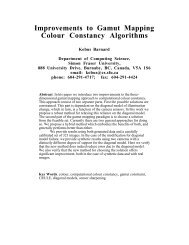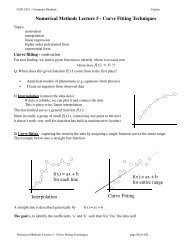1 Introduction
1 Introduction
1 Introduction
- No tags were found...
Create successful ePaper yourself
Turn your PDF publications into a flip-book with our unique Google optimized e-Paper software.
1.2. Probability Theory 19that the probability of x falling in an infinitesimal volume δx containing the point xis given by p(x)δx. This multivariate probability density must satisfy∫p(x) 0 (1.29)p(x)dx = 1 (1.30)in which the integral is taken over the whole of x space. We can also consider jointprobability distributions over a combination of discrete and continuous variables.Note that if x is a discrete variable, then p(x) is sometimes called a probabilitymass function because it can be regarded as a set of ‘probability masses’ concentratedat the allowed values of x.The sum and product rules of probability, as well as Bayes’ theorem, applyequally to the case of probability densities, or to combinations of discrete and continuousvariables. For instance, if x and y are two real variables, then the sum andproduct rules take the form∫p(x) = p(x, y)dy (1.31)p(x, y) = p(y|x)p(x). (1.32)A formal justification of the sum and product rules for continuous variables (Feller,1966) requires a branch of mathematics called measure theory and lies outside thescope of this book. Its validity can be seen informally, however, by dividing eachreal variable into intervals of width ∆ and considering the discrete probability distributionover these intervals. Taking the limit ∆ → 0 then turns sums into integralsand gives the desired result.1.2.2 Expectations and covariancesOne of the most important operations involving probabilities is that of findingweighted averages of functions. The average value of some function f(x) under aprobability distribution p(x) is called the expectation of f(x) and will be denoted byE[f]. For a discrete distribution, it is given byE[f] = ∑ xp(x)f(x) (1.33)so that the average is weighted by the relative probabilities of the different valuesof x. In the case of continuous variables, expectations are expressed in terms of anintegration with respect to the corresponding probability density∫E[f] = p(x)f(x)dx. (1.34)In either case, if we are given a finite number N of points drawn from the probabilitydistribution or probability density, then the expectation can be approximated as a





